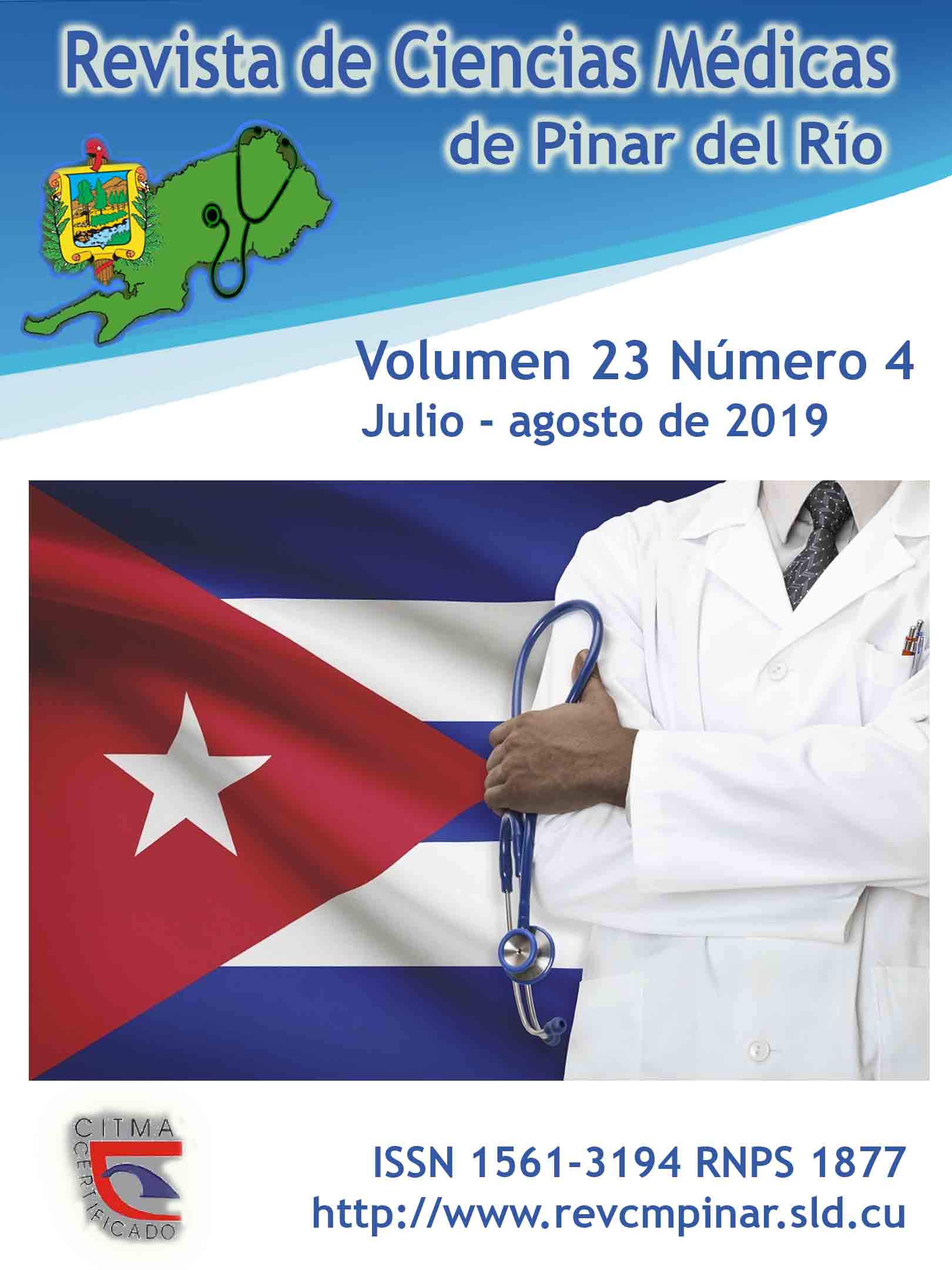Resolution for minimum access in anal extrusion of peritoneal ventricle shunt catheter
Keywords:
PATIENT, CATHETERS, LAPAROSCOPY/surgery, PERITONEAL CAVITY, TRANSANAL ENDOSCOPIC SURGERY.Abstract
Introduction: there are multiple complications of peritoneal ventricle shunt, including infection of the shunt, obstruction and disconnection, are the most frequent. On the other hand, cerebrospinal fluid pseudo cyst, inguinal hernia, hydrocele and intestinal perforation are rare.
Objective: to describe a laparoscopic surgery as a method of treatment of anal catheter extrusion as a complication of peritoneal ventricular bypass.
Case report: a patient with a neurosurgery because of a cholesteatoma of the clivus, to which a peritoneal ventricle derivation is made due to a hydrocephalus secondary to the compression of the floor of the third ventricle, by the suprasellar growth of the lesion. The patient came to the Neurosurgery Service because of extrusion of the distal end of the catheter through the anus. After confirming this complication through colonoscopy, laparoscopic surgery was performed to remove the extruded end.
Conclusions: the patient evolved without post-surgical complications and was discharged from the hospital. Minimal access surgery offers advantages over laparotomy in the resolution this complication.
Downloads
References
1. Parra Blasco WS. León F, Mendieta Marcillo G. Extrusión anal de la derivación ventrículo- peritoneal a propósito de un caso. [Internet] S/N [citado 20/05/2019]; 4(3). Disponible n: https://docplayer.es/36268639-Extrusion-anal-de-la-derivacion-ventriculoperitoneal-a-proposito-de-un-caso.html
2. Farazi MMA, Salam MA, Azim MA. Transanal Extrusion of the Ventriculoperitoneal Shunt Tube. Medicine Today. [Internet] 2016 [citado 20/05/2019]; 27(2): [aprox. 1p.]. Disponible en: https://www.researchgate.net/publication/309383236_Transanal_Extrusion_of_the_Ventriculoperitoneal_Shunt_Tube
3. Castillo Juan L. Migración de catéter de derivación ventrículo peritoneal a través de colon. Reporte de un caso y revisión de la literatura. Revista de especialidades médico quirúrgicas. [Internet] mayo-agosto 2007 [citado 20/05/2019]; 12(2): [aprox. 4p.]. Disponible en: http://www.redalyc.org/articulo.oa?id=47311505010
4. Leyva Mastrapa T, Barreras González JE, Alonso Fernández L, Quintana Pajón I, Suarez Limonta D, Barrios Osuna IO. Manejo laparoscópico de pseudoquiste abdominal en paciente hidrocefálico. Rev Cubana Cir [Internet] oct.-dic. 2015 [citado 20/05/ 2019]; 54(4).Disponible en: http://scielo.sld.cu/scielo.php?script=sci_arttext&pid=S0034-74932015000400011
5. Jimena Ortiz-Rivera C. La desnutrición incrementa riesgo de perforaciones en pacientes con derivación ventrículo peritoneal. Revista Gastrohnup [Internet] 2017 [citado 20/05/2019]; 19(2 Supl2): [aprox. 3p.]. Disponible en: http://gastropediatria.org/a17v19n2s2/a17v19n2s2e9-e12.pdf
6. Baeza-Herrera C, Atzín-Fuentes JL, Velasco-Soria L, García-Cabello LM, Godoy-Esquivel AH. Amputación y expulsión rectal de catéter de derivación subaracnoideo-peritoneal. Medigraphyc Artemisa. [Internet] marzo-abril 2007 [citado 20/05/2019]; 64(2): [aprox. 4p.]. Disponible en: http://www.scielo.org.mx/scielo.php?script=sci_arttext&pid=S1665-11462007000200006&lng=es
7. Uparela Reyes MJ, Manrique Díaz KA, Ferreira Prada CA. Migración del catéter de derivación ventriculoperitoneal con protrusión por cavidad oral Reporte de un caso y revisión de la literatura. Neurocienc. colomb. [Internet] Junio 2017 [citado 20/05/2019]; 24(2): [aprox. 82p.]. Disponible en: http://www.acncx.org/images/revistas/pdf/Revista-neurociencias-2-4.pdf
8. Sosuncu E, Gülşen I, Kıymaz N, Ağengin K, Şimşek M, Melek M. Anal Protrusion Caused by a Ventriculoperitoneal Shunt. Van Tıp Derg [Internet] 2016 [citado 20/05/2019]; 23(1): [aprox. 3p.]. Disponible en:
https://pdfs.semanticscholar.org/1a93/d81769deb75f8c68d9ad28247f1bc5447c28.pdf
9. Phani K. Department of Neurosurgery, GSL Medical College, Rajahmundry, Andhra Pradesh, India. Transanal protrusion of ventriculo-peritoneal shunt catéter. [Internet] 2013 [citado 20/05/2019]; 2(2): [aprox. 2p.]. Disponible en: http://www.jdrntruhs.org/article.asp?issn=2277-8632;year=2013;volume=2;issue=2;spage=115;epage=117;aulast=Phani
10. Alvis Ladislao F, Herrera Daniela F. Complicaciones poco frecuentes de la derivación ventrículo peritoneal en el Hospital del Niño Manuel Ascencio Villarroel. Rev Cient Cienc Méd [Internet] 2013 [citado 20/05/2019]; 16(2): [aprox. 2p.]. Disponible en: http://www.scielo.org.bo/scielo.php?script=sci_arttext&pid=S1817-74332013000200009
Published
How to Cite
Issue
Section
License
Authors who have publications with this journal agree to the following terms: Authors will retain their copyrights and grant the journal the right of first publication of their work, which will be publication of their work, which will be simultaneously subject to the Creative Commons Attribution License (CC-BY-NC 4.0) that allows third parties to share the work as long as its author and first publication in this journal are indicated.
Authors may adopt other non-exclusive license agreements for distribution of the published version of the work (e.g.: deposit it in an institutional telematic archive or publish it in a volume). Likewise, and according to the recommendations of the Medical Sciences Editorial (ECIMED), authors must declare in each article their contribution according to the CRediT taxonomy (contributor roles). This taxonomy includes 14 roles, which can be used to represent the tasks typically performed by contributors in scientific academic production. It should be consulted in monograph) whenever initial publication in this journal is indicated. Authors are allowed and encouraged to disseminate their work through the Internet (e.g., in institutional telematic archives or on their web page) before and during the submission process, which may produce interesting exchanges and increase citations of the published work. (See The effect of open access). https://casrai.org/credit/



